Do I need to tie up watermelons in a polycarbonate greenhouse?
With the greenhouse method of growing, a garter of plants is necessary. Correctly tying up watermelons in a greenhouse means preserving the crop and allowing it to fully ripen. The fruits of melons and gourds are impressive in size, and they simply need support. Due to the fact that the space in the greenhouse structure is limited, vertical supports are built for watermelons, allowing rational use of every centimeter of the area.
Benefits of growing in a greenhouse
Using a greenhouse, watermelons can be grown not only in the southern regions, but also in the middle lane and in the northern regions. For temperate and cold climates, varieties with early ripening are ideal:
- "Ogonyok";
- "Siberian";
- Crimson;
- "Sugar";
- "Florida".
A polycarbonate greenhouse will reliably protect watermelons from adverse environmental influences. In indoor conditions, it is possible to create an ideal microclimate that exactly matches the needs of the melons and gourds.
Plants will not be disturbed by rainfall or wind, whips will be protected from damage by animals and pests.
The main advantage of growing watermelons in a greenhouse is to improve the taste of watermelon pulp. Indoors, the fruits will be able to fully ripen and collect a significant amount of sugar. Melons can be grown in the same way.
Lash garter
In the greenhouse, watermelons form whips up to 10 m long, the weight of the fruit reaches 2–3 kg. Plants are fixed on trellises. The support can be either purchased or made independently.
Garter rules:
- Watermelons are formed into one stem, completely removing shoots without ovaries. The remaining branches are pinched.
- The number of fruits must be normalized; no more than 4–6 ovaries are left on one plant.
- The lash is tied to the support when the plant reaches 1 meter.
- It is recommended to lay the lower part of the stem on the ground and sprinkle it with soil so that the vine can receive more nutrition by growing additional roots.
With such an organization of the garter, it will be possible to avoid excessive thickening of the plants and achieve a rational use of the greenhouse area. Tied plants are much easier to care for.
Types of tapestries used
In order to properly tie up the plants, arch-type trellises are best suited. They are installed along the entire greenhouse. The number of trellises depends on the number of plants grown. Arched trellises can be purchased or homemade.
They can be made from metal-plastic pipes or fittings. The installation should be carried out before the planting of watermelon seedlings in the greenhouse. The structure must be reliable: the support will carry the load from the entire vegetative mass, including fruits.
Arches are convenient in that one watermelon is tied to one support on each side, which means that the trellis can easily withstand the weight of fruiting plants.
It is permissible to install a U-shaped trellis, placing it along the greenhouse wall. The support can be made of lateral wooden or metal posts. The crossbar is made from a bar under the ceiling of the greenhouse. If the structure is long, it can be reinforced with 1–2 additional props or crossbars in the middle.
In the future, a strong twine or rope is tied to the crossbar in front of each plant - the whips will be tied to it.
Due to the high weight of the loaded trellis, it is necessary to securely fix the support pillars by digging them into the ground by 50-60 cm. For greater stability, the base of the supports can be concreted.
Garter materials
The stalks of the watermelon cannot cling to the trellis themselves, so they must be tied up. For this purpose, twine, ribbons made of soft fabric, special clamps are used:
- Twine should not be too thin, otherwise after the garter it will begin to dig into the tissue of the shoots, damaging them. Pathogenic microflora can easily penetrate through the wounds. In addition, tissue trauma is stressful for the plant.
- the cloth should be thin and dry quickly. A rag is often used as a garter material, cutting it into strips 2 cm wide and 20–25 cm long. If possible, you can use old nylon tights or stockings.
- Fasteners (clips) for garter usually made of plastic. You can buy them where gardening supplies are sold. They are also found in the Fixe-Price chain of stores. The gadgets are similar in appearance to clothespins and come in different sizes. Sometimes a set includes both large and small clips. Using them, you can tie up all the plants in the greenhouse at once in a few minutes.
- Advanced option - using a stapler (taper) for garter plants. Brackets and nylon tape are sold with it. With the help of the device, you can quickly tie the lashes of watermelons. The price of staplers starts at 1,500 rubles, so it's worth first assessing the feasibility of such a purchase. If there are many landings on the site that require a garter, such an acquisition makes sense.
You should not tie watermelons to a trellis with a thin wire or fishing line: they can easily injure and pinch the whips, which will make it difficult for nutrients to access the fruits.
Fruit support methods
In the process of growth, the fruits gain considerable weight. They need to provide support to prevent damage and breakage of the whips.
A common method is placing each fruit in a net. After the berry is laid inside, the net is attached to the trellis. With this method, watermelons receive a lot of sunlight, they are provided with free air circulation. As a result, the risk of diseases is reduced, the berries ripen well.
An economical option would be to buy a mesh from the manufacturer in an online store.
For the manufacture of mesh packaging, nylon is used. This mesh is durable, does not absorb moisture, and lasts for several seasons. It is cut into "sleeves" 45-50 cm long. Tied with a knot from the bottom. After placing the watermelon in the net, the upper edge is also tied, leaving room for the free passage of the stalk, and tied to the trellis with twine.
Sometimes watermelons are simply tied up by the stem to the trellis. This method is considered less reliable. It is usually used when there is a lack of time.
Various stands can be used to support the fruit. In this capacity, cut off cans, old buckets, homemade wooden or plastic shelves, which are fixed on a support, can act.
Tying watermelons is a mandatory procedure when growing them on vertical trellises. If the lashes are not fixed, they will need a lot of free space, and the fruits lying on the ground will not reach the standard size due to the reduced illumination. Without the use of trellises, the risk of diseases increases, which means that the harvest can not wait at all.
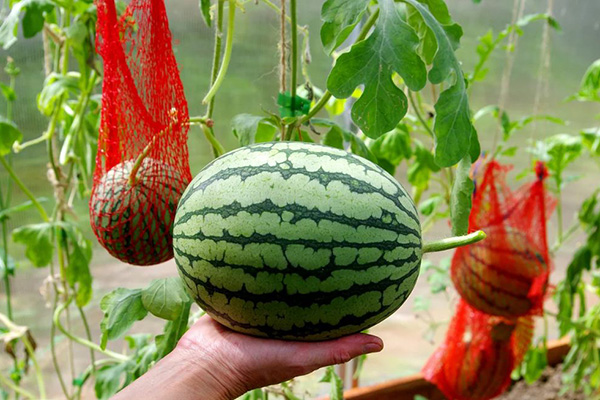
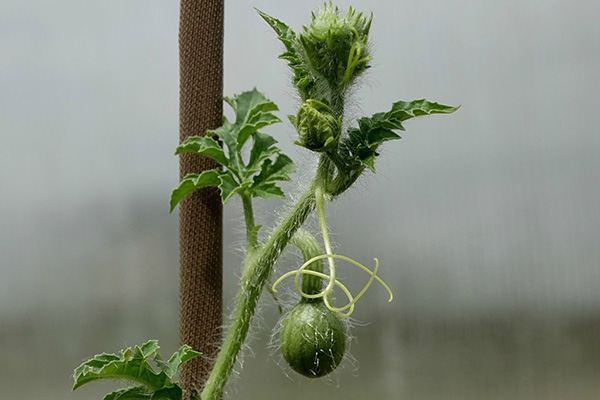
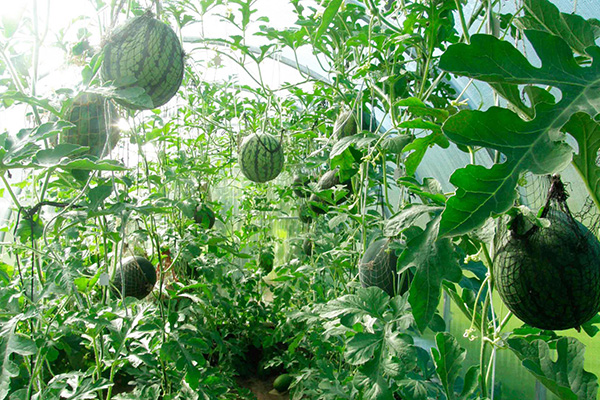
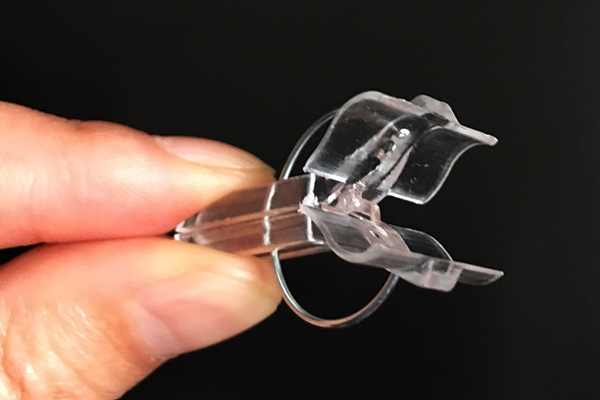
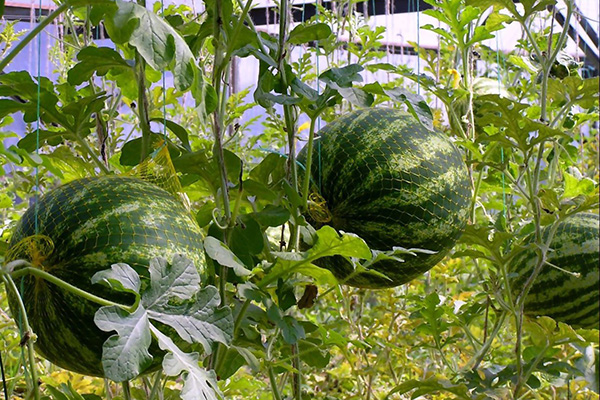
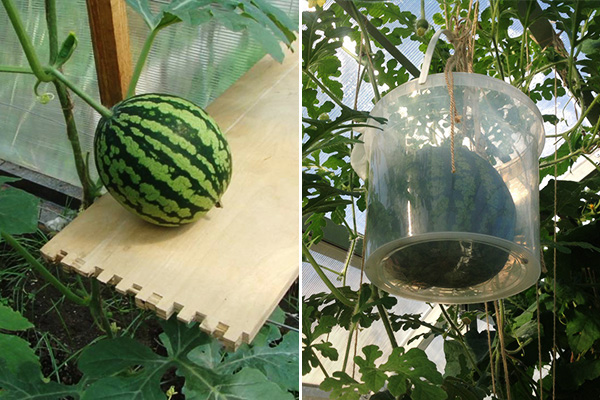

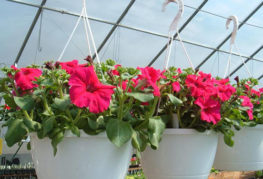
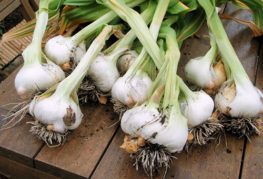

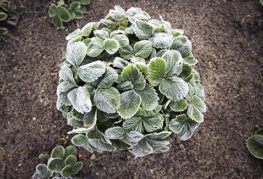
and will be published shortly.